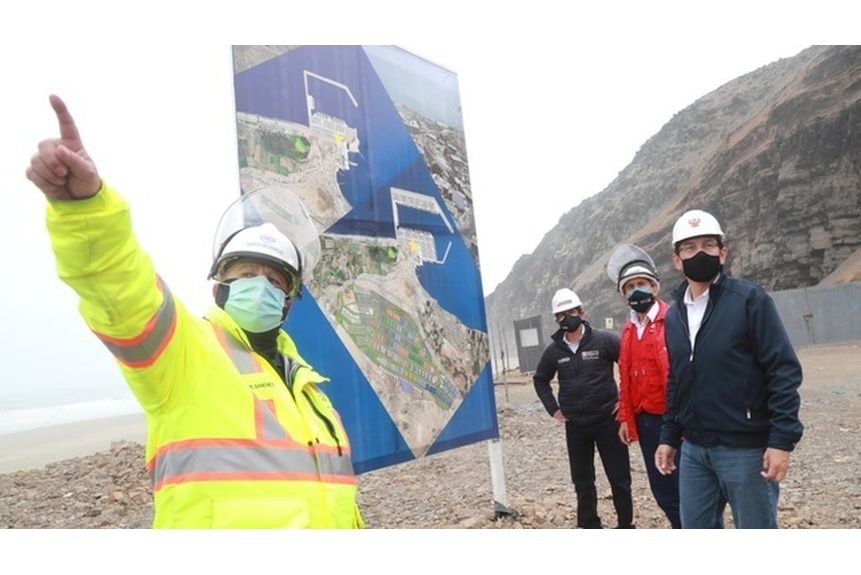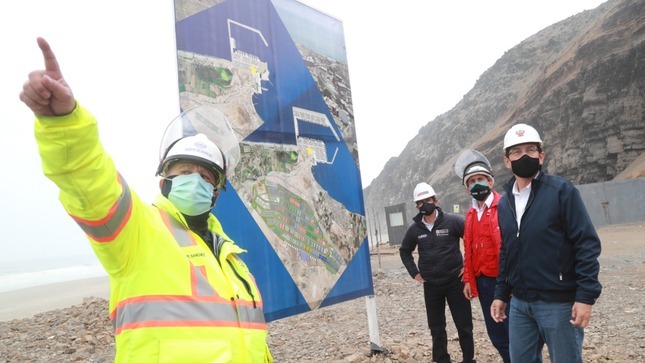
China Nears Completion of Large Port in Peru With Dual-Use Capabilities
By Ryan Berg

A worker stands in front of a map depicting the massive Port of Chancay in Peru.
“Cosco Shipping seeks to improve China’s access to minerals from the mountains to the coast, and from there execute shipments through the port of Chancay.”
Weeks after the tenth anniversary of its Belt and Road Initiative (BRI), China is on schedule to inaugurate one of its biggest port development projects to date: the $3 billion Port of Chancay, just north of Lima, Peru. In recent years, Chinese-owned and operated deep-water ports around the world have captured the attention of many analysts for their dual-use potential, for both commercial and military purposes.[i] In the past, China has used its owned and operated ports as logistical points and ports of call for the People’s Liberation Army Navy (PLAN).[ii] Chinese-owned and operated ports also offer the potential for China to track data on trade flows, which could open the door to economic coercion against the host countries as well as other third-party countries.
In response to rising questions about the Port of Chancay project, Peruvian media conglomerate RPP reports the Peruvian government maintains that the port is purely economic in nature and that the local population will be compensated for displacement and any environmental damage to the surrounding areas. The second excerpted article in the Peruvian energy and mining-focused news outlet Energiminas, says that the port will play an important role in helping China to solidify its dominant position in Latin America’s critical minerals supply chains.[iii] Peru also maintains that the port, built by Chinese state-owned enterprise Cosco Shipping, will save an average of 10 to 12 days on goods traveling to Asia from Latin America. Further, the Peruvian government has confirmed its commitment to the project and stated its goal is to leverage its role as host of the Asia-Pacific Economic Cooperation in 2024 to officially inaugurate the Port of Chancay. China has dozens of contracts to upgrade, build, and/or operate deep-water ports in the Western Hemisphere, an economic reality with implications for the region’s operational environment. Given China’s past use of deep-water ports for naval port calls, the Western Hemisphere may soon witness an uptick in the PLAN presence.
Sources:
“Puerto de Chancay estaría listo para iniciar funcionamiento a fines de noviembre de 2024 (Port of Chancay would be ready to start operations at the end of November 2024),” RPP (Peruvian radio, television, and print media company located in Lima), 23 October 2023. https://rpp.pe/economia/economia/puerto-de-chancay-estaria-listo-para-iniciar-funcionamiento-a-fines-de-noviembre-del-2024-noticia-1512135?ref=rpp
The port of Chancay would finally be inaugurated in November 2024 with cutting-edge technology…‘we hope to finish the port at the end of November 2024 and inaugurate it on that date taking advantage of the APEC Summit’…‘We have more than 3,000 families registered with a baseline of the conditions of their house and with a commitment letter from Cosco, responsible for solving any environmental damage,’ said an official with the company.
“Puerto de Chancay evalúa mejoras en acceso de inerals de sierra de Oyón a la costa, señala Gobierno Regional de Lima (Port of Chancay evaluates improvements in access of minerals from the Sierra de Oyón to the coast, says Regional Government of Lima),” Energiminas (Peruvian news outlet focused on the country’s energy and mining sectors) 18 October 2023. https://energiminas.com/puerto-de-chancay-evalua-mejoras-en-acceso-de-minerales-de-sierra-de-oyon-a-la-costa-senala-gobierno-regional-de-lima/
The Regional Government of Lima indicated that the operator Cosco Shipping seeks to improve China’s access to minerals from the mountains to the coast, and from there execute shipments through the port of Chancay…For the Peruvian Ministry of Transport and Communications, this megaproject, led by the Chinese company Cosco Shipping, is key for international trade and will be a hub that will redistribute cargo from the countries of Chile, Ecuador and Colombia as well.
Notes:
[i] For a useful dashboard of Chinese-owned and operated ports around the world, see: “Tracking China’s Control of Overseas Ports,” Council on Foreign Relations, 6 November 2023. https://www.cfr.org/tracker/china-overseas-ports
[ii] Researchers tracking Chinese port calls have found that the PLA Navy has called at about one-third of the nearly 100 Chinese owned and operated ports overseas. See: Jennifer Rice and Erik Robb, “The Origins of Near Seas Defense and Far Seas Protection,” CMSI China Maritime Report, no. 13 (February 2021).
[iii] For more information on China’s role in Latin America’s minerals exploration and production, see: Ryan C. Berg, “China Deepening Cooperation in Latin America’s Sizeable Lithium Sector,” OE Watch, 01-2023. https://community.apan.org/wg/tradoc-g2/fmso/m/oe-watch-articles-2-singular-format/434262
Image Information:
Image: A worker stands in front of a map depicting the massive Port of Chancay in Peru.
Source : https ://commons.wikimedia.org/wiki/File :Puerto_Chancay_2.jpg
Attribution: Wikimedia, CC BY-SA 4.0 DEED
Distribution A: Approved for public release
Categories:
Tags:







